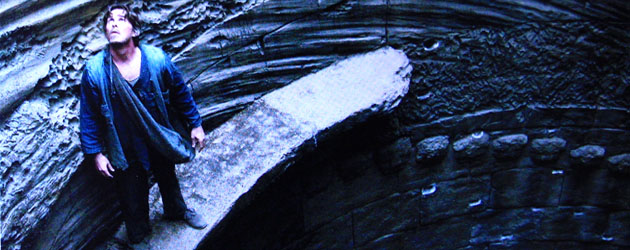Nathan Crowley

Even if the film wasn’t in LA we’d go downtown and say, Let’s talk about it as if we could shoot it here. We’d go out wandering. We’d spend the whole day. We’d have breakfast, wander, go back to the garage and then go out again. And when the films got bigger it was like, Okay, let’s go to India. Let’s go wandering around India. Let’s go to Iceland.
AS: You went out to do research in foreign countries?
NC: Yes. In the beginning we went to Iceland and walked around Iceland. We’d go hiking up the glaciers and ravines all day long. We wanted the landscape in Batman Begins to mean something. To show Batman’s journey. In the Dark Knight Rises we wanted to use landscapes again. Go somewhere remote. Bane would have come from somewhere remote. I’d been looking at stepwells in India. We flew to India and literally got in a car and drove from Dehli to Mumbai. Crazy few days. Then we flew to Romania and ended up in the giant salt mines wondering if we should change the Batcave.
You find the entire film scouting, but you know you have to give something up. You have to decide what you can and what you can’t achieve. Find another version that’s satisfactory. Compromise on some elements and hold fast on others.
It’s brilliant having Chris there with me. We often walk all day discussing each scene. He’s putting his version of each scene in my head. I’m sure he does it on purpose because he knows he’ll get more out of me! One of the most important things for a designer and one of the things you don’t often have time to do is put the script into your head. Know it inside out. Know scene order and structure. You should know that when you’re scouting. You need to be playing the film in your head and hopefully it’s the same film as the director.
You might be scouting something specifically in the script, say, Japanese restaurants, and you might find a location and say, My God, we gotta use this for this other scene one hundred pages earlier. It becomes a giant jigsaw puzzle. Keeping the process loose you allow for the evolution of ideas. You don’t necessarily have to scout for one thing you can scout with the whole film in mind. That early pre-pre-production is really essential. It’s where the film is designed. It’s not designed in preproduction. It’s designed in Chris’ garage. When we leave that garage we have to suddenly instruct two hundred people what the entire film should look like.
But all these things are gonna change. All these thousands of things come at you, the money, the visual effects, the actors’ schedules, what you can do practically, what the problems are. But you’re prepared for the bombardment. That’s why you’re doing the early work in the garage.
AS: Do you favor practical locations over building sets on a stage?
NC: Building a set is more about, Are we going to have this actor available on this date? Do we need to flood this or blow it up? Not like, Oh, we have to build this set. We don’t have to build anything. You can build it on location. Like the Batcave. We were going to put it into a real cave to begin with. It should be a real cave. It must be believable. It’s a hiding place. But then we decide we want to jump a real Batmobile into it and have a waterfall and river. So you end up building a set based on an existing cave you scouted. Design should be in the background. You shouldn’t question whether it’s a set. You shouldn’t say at the end of the film, Oh, wow, that’s a cool set. Then somehow you’ve failed.
Pingback: Rick Heinrichs